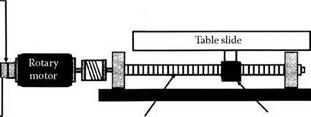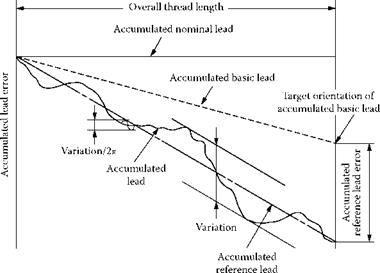A ballscrew (or recirculating ball leadscrew) is at the heart of a controlled linear-motion system. It is a precision-ground hardened steel or stainless steel threaded shaft on which a ballnut rides with rolling contact to provide a positive, high efficiency of transmission and low friction. The ballscrew is manufactured by turning, heat treating, and then finish grinding the thread. In the process of finish grinding, the shaft will “unwind” developing a lead error both cyclic and accumulative. Some of this is compensated in the grinding process but nevertheless there is a residual error (Figure 15.9).
The class of ballscrew is governed by a combination of accumulated lead error and cyclic variation. For a nominal 1-m length, a C0 class would have <8-pm accumulated error and <6-pm variation,
|
|
||
|
|||

![]()
![]()
![]()
![]()
 Servo
Servo
amplifier
Rotary encoder
or tachometer
feedback
FIGURE 15.19 Typical closed-loop servodrive ballscrew system.
while a C3 class would have <21-pm accumulated error and <15-pm of variation. Accumulated error can be programmed into modern CNC controls as an offset to correct for the error.
Lower-quality ballscrews are made by rolling the form then heat treating. They are sometimes used on low-cost surface grinders, axes requiring noncritical accuracies, or for materials-handling and peripherals.
 |
Mounting of the ballscrew is somewhat dependent on the speed of operation and personal preference. For grinders, the end coupled to the servomotor is always held fixed using a pair of angular contact bearings. The other end may also be fixed with a similar bearing arrangement or just supported with a plane bearing. Fixing the bearing at both ends provides the greatest stiffness and raises the critical speed at which vibration is induced and is used especially for higher speed requirements. A single fixed end allows for thermal expansion without distortion of the screw (Figure 15.20).
 |
However, heat is also expected to be a greater issue with higher speed. For this reason, screws fixed at both ends for higher speeds are often preloaded axially to allow for some expected thermal growth. Hollow screws are also available through which coolant can be pumped to control thermal expansion.
